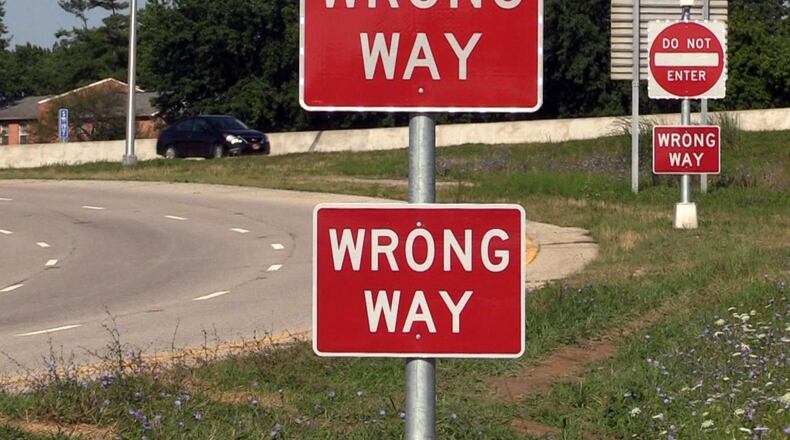Jennings’ sister, 8-year-old Adriana Sanchez, was critically injured in the crash.
Ohio Department of Transportation spokesman Matt Bruning said that crash was not a wrong-way crash, which typically occurs when someone enters a highway from an exit ramp, uses an emergency crossover to make a U-turn or intentionally makes a U-turn in the middle of a busy roadway.
MORE: 3 Middletown family members killed in wrong-way I-75 crash: What to know today
Instead, Friday’s incident is considered a crossover crash, or cross-median crash, he said. Despite the cable barriers not stopping the semi from going into oncoming traffic, they are safer than other types of barriers and reduce wrong-way and fatal crashes, Bruning said.
“When we analyzed some of the locations that have had cable barriers for a while, we found they reduced cross-median crashes by 91 percent, fatalities by 83 percent and serious injuries by 98 percent,” he said.
But they can’t stop every incident.
“I don’t anticipate a cable barrier like that to stop a vehicle like that,” said Moraine police Sgt. Andrew Parish.
About 17 percent of crashes into cable barriers result in injuries, compared to 38 percent involving concrete barriers and 34 percent involving guardrails, Bruning said. Cable barriers help “capture” vehicles to prevent them from traveling across the median into oncoming traffic or bouncing back into traffic.
The cable barriers cost $95,000 per mile, Bruning said.
MORE: Middletown victims of fatal I-75 wrong-way crash ‘always together’
Last Friday’s cross-median crash was the latest in a rising number of fatal incidents involving drivers on the wrong side of the road.
In 2019, Ohio saw 31 wrong-way crashes resulting in 34 deaths, according to state data. That was 19 more than in 2018 and more than any year dating back to 2013.
Since 2016, there have been 102 wrong-way crashes, 83 deaths and 172 injuries, according to ODOT. While wrong-way crashes made up less than .01 percent of all crashes in Ohio last year, they are 40 times more likely to be fatal, ODOT said.
Although crashes caused by wrong-way drivers or crossover crashes may seem to be happening frequently, that’s not the case, Bruning said.
However, “when they happen, they’re usually awful, and (news outlets are) usually reporting on them because they usually end in serious injury or a fatality,” he said. “They’re usually going to occur on a high-traveled roadway, so they impact traffic for several hours.”
MORE: Wrong-way crashes: 9 have died in recent southwest Ohio incidents
ODOT is taking steps to prevent such crashes. Motorists in Greene, Hamilton and Montgomery counties will soon see more highway signs alerting and detecting wrong-way driver. It’s focusing on 17 counties where officials said 82 percent of wrong-way crashes in Ohio have occurred on highway ramps and the vast majority of Ohio’s nearly 50 wrong-way fatalities have occurred since 2016.
Aside from Greene, Hamilton and Montgomery, they include Cuyahoga, Belmont, Franklin, Jefferson, Lake, Licking, Lorain, Lucas, Mahoning, Richland, Stark, Summit, Trumball and Wood.
Last July, ODOT announced a program to detect and deter wrong-way drivers with 92 electronic signs and 82 detection devices. It started at 23 locations along an 18-mile stretch of I-71 in Hamilton County from downtown Cincinnati to Fields-Ertel Road.
When it is activated, LED lights around the edge of several “wrong way” and “do not enter” signs will begin to flash. An alert will also be sent to ODOT’s Traffic Management Center in Columbus.
The system, which went live in October, has already stopped a handful of wrong-way drivers from entering the busy I-71 roadway, Bruning said.
“Each time we’ve seen a driver enter the wrong way with this detection system, that driver has either turned around on the ramp or at least not gotten involved in a crash,” he said.
The announcement about installation of those devices came the same day not guilty pleas were entered for Abby Michaels, a 21-year-old who authorities said was deliberately driving northbound in the southbound lanes of I-75 last March when she was involved in a crash that killed three members of a Mason family. She was indicted on six counts of murder, six counts of aggravated vehicular homicide and operating a vehicle while under the influence of alcohol.
MORE: Driver in wrong-way crash that killed Mason family members wants tests tossed
Michaels is charged with six counts of murder, six counts of aggravated vehicular homicide and OVI for the deaths of husband and wife Karen and Timmy Thompson, and their 10-year-old daughter, Tessa, all of Mason.
Fatalities in Wrong-Way Crashes in Ohio (2013-2019)
2019: 34
2018: 15
2017: 16
2016: 18
2015: 8
2014: 7
2013: 11
Cross Median crashes (2013-2017)
2017: 306
2016: 233
2015: 219
2014: 257
2013: 307
Source: Ohio Department of Transportation
WRONG WAY CRASH
• applies to divided highways only (i.e. a vehicle entering the wrong ramp and thus entering and traveling a route in the wrong direction)
• vehicle must actually be traveling in the opposite direction of the lane before resting
CROSS MEDIAN CRASH
• applies to divided highways only
• vehicle must travel into/across the opposite lane of traffic beyond the median. If the vehicle is only in the opposite lane berm, it does not count.
• cross medians on ramps do not count
• crashes occuring at an intersection do not count
• if cross median was intentional, (i.e. U-turn), it does not count
Source: Ohio Department of Transportation
About the Author

